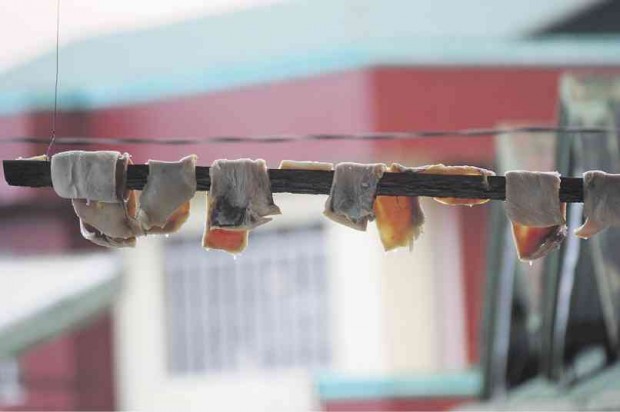We’ve not yet seen the last of Etag Festival

SMOKIN’ Whether or not Sagada wants to be branded as ‘Etag’ country, this raw smoked pork (photo below) remains its cultural heritage. PHOTOS BY RICHARD BALONGLONG
 THIS YEAR would have seen the last of the Etag Festival in the tourist town of Sagada in Mt. Province.
THIS YEAR would have seen the last of the Etag Festival in the tourist town of Sagada in Mt. Province.
But without any consensus as to whether using “etag” as a Sagada brand no longer serves the community, residents pressed on with the 6th staging of the town’s crowd-drawing event on Jan. 30 with street parades, a “cañao” (ritual feast) food for participants and a unity dance to bring all Cordillera cultures together.
The festival, which is held annually from Jan. 30 to Feb. 2, was introduced in 2011 to popularize etag, a smoked pork of Mt. Province. Like its Ilocano version “bagnet,” etag garnishes broths served in restaurants or homes in the Cordillera.
But some residents—horrified by the likely over commercialization of the tourist town—believe the festivities should be centered once more on the old Sagada town fiesta held on the first weekend of February.
The old fiesta drew its roots from the Feast of the Purification and the Presentation of Jesus Christ and the Holy Virgin Mary that was introduced during the Spanish colonial era.
Sagada may be one of the most visited communities in the Cordillera but its residents have been very protective of their own culture.
Robert Pangod, the municipal tourism officer, said nothing has been decided as to whether this year’s Etag Festival would be the last because no one has come forward with a formal resolution.
Not enough etag
The reversion to the Sagada fiesta has gone the rounds in local coffee shops because of the argument that the community could not produce enough etag for the festivities.
“Panag-etag” (the process of making etag) requires the butcher to rub portions of a freshly butchered pig with a generous amount of salt, before these slabs of meat are strung up above a smoking pile of coal or wood for curing.
The taste of smoked meat depends on the wood used, so etag-makers prefer redwood, dried birch or
orange tree branches when smoking the meat for days until it is fully dried.
Francisco Masferre, a 58-year-old etag-maker, said dropping etag as a community brand would be unfortunate because the festival advocates the smoked meat’s cultural relevance, not the product.
Sagada Mayor Eduardo Latawan said etag is part of Mt. Province life—from the day a villager is born to the time of his passing. Because of the terrain, the meat has to be shared and preserved by the community until hunters bag big game in the next round of hunting.
Etag is apportioned and shared during “geb-gebbaw” (a ritual similar to baptism) for a newly born child. Etag is shared in birthdays, weddings and even funerals.
“I acknowledge that there is not enough etag to go around [during the festivals] so we are encouraging more people in our town to venture into etag-making,” Latawan said. With a report from Jessica Tabilin














